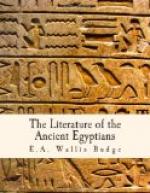[Footnote 1: The second version here states that the name of Nebertcher is Ausares (Osiris), who is the oldest god of all.]
The gods and goddesses next created were five, namely, Osiris, Horus, Set, Isis, and Nephthys. Osiris married Isis, and their son was called Horus; Set married Nephthys, but their son Anpu, or Anubis, is not mentioned in our text. Osiris became the great Ancestor-god of Egypt, and was a reincarnation of his great-grandfather. Men and women were first formed from the tears that fell from the Eye of Khepera, or the Sun-god, upon his body; the old Egyptian word for “men” very closely resembles in form and sound the word for “tears.” Plants, vegetables, herbs, and trees owe their origin to the light of the moon falling upon the earth. Our text contains no mention of a special creation of the “beasts of the field,” but the god states distinctly that he created the children of the earth, or creeping things of all kinds, and among this class quadrupeds are probably included. The men and women, and all the other living creatures that were made at that time by Nebertcher, or Khepera, reproduced their species, each in his own way, and thus the earth became filled with their descendants as we see at the present time. The elements of this Creation legend are very, very old, and the form in which they are grouped in our text suggests the influence of the priests of Heliopolis. It is interesting to note that only very ancient gods appear as Powers of creation, and these were certainly worshipped for many centuries before the priests of Heliopolis invented their cult of the Sun-god, and identified their god with the older gods of the country. We may note, too, that gods like Ptah and Amen, whose reputation was so great in later times, and even when our text was copied in 305 B.C., find no mention at all.
CHAPTER VII
LEGENDS OF THE GODS
The Egyptians believed that at one time all the great gods and goddesses lived upon earth, and that they ruled Egypt in much the same way as the Pharaohs with whom they were more or less acquainted. They went about among men and took a real personal interest in their affairs, and, according to tradition, they spared no pains in promoting their wishes and well-being. Their rule was on the whole beneficent, chiefly because in addition to their divine attributes they possessed




